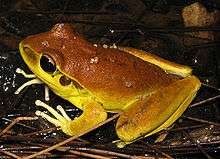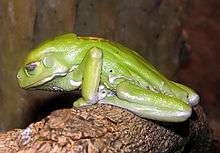Hylidae
| Hylidae Temporal range: 57–0 Ma | |
|---|---|
 | |
| Red-eyed tree frog, Agalychnis callidryas | |
| Scientific classification | |
| Kingdom: | Animalia |
| Phylum: | Chordata |
| Class: | Amphibia |
| Order: | Anura |
| Suborder: | Neobatrachia |
| Family: | Hylidae Rafinesque, 1815 |
| Genera | |
|
See text. | |
| | |
| Distribution of Hylidae (in black) | |
The Hylidae are a wide-ranging family of frogs commonly referred to as "tree frogs and their allies". However, the hylids include a diversity of frog species, many of which do not live in trees, but are terrestrial or semiaquatic.
Characteristics
Most hylids show adaptations suitable for an arboreal lifestyle, including forward-facing eyes providing binocular vision, and adhesive pads on the fingers and toes. In the nonarboreal species, these features may be greatly reduced, or absent. The Cyclorana species are burrowing frogs that spend much of their lives underground.[1]
Hylids mostly feed on insects and other invertebrates, but some larger species can feed on small vertebrates.
Hylids lay their eggs in a range of different locations, depending on species. Many use ponds, or puddles that collect in the holes of their trees, while others use bromeliads or other water-holding plants. Other species lay their eggs on the leaves of vegetation hanging over water, allowing the tadpoles to drop into the pond when they hatch.[1]
A few species use fast-flowing streams, attaching the eggs firmly to the substrate. The tadpoles of these species have suckers enabling them to hold on to rocks after they hatch. Another unusual adaptation is found in some South American hylids, which brood the eggs on the back of the female. The tadpoles of most hylid species have laterally placed eyes, and broad tails with narrow, filamentous tips.[1]
Type species
The European tree frog, Hyla arborea, is common in the middle and south of Europe, and ranges into Asia and North Africa. The species becomes very noisy on the approach of rain and is sometimes kept in confinement as a kind of barometer.
North America has many species of the Hylidae family, including the Gray tree frog (Hyla versicolor) and the American green tree frog (H. cinerea). The spring peeper (Pseudacris crucifer) is also widespread in the eastern United States and is commonly heard on summer and spring evenings.
"Tree frog" is a popular name for several of the Hylidae. H. versicolor is the changeable tree frog, Trachycephalus lichenatus is the lichened tree frog, and Trachycephalus marmoratus is the marbled tree frog. However, the name "treefrog" is not unique to this family, also being used for many species of the Rhacophoridae.
Rabbs' fringe-limbed tree frog, Ecnomiohyla rabborum, was a species of Hydilae that went extinct in September 2016. The last of its kind, a male named Toughie died on September 30, when it was pronounced that the species had become extinct.
 Hyla versicolor, North American gray tree frog
Hyla versicolor, North American gray tree frog Litoria wilcoxi, stony creek frog
Litoria wilcoxi, stony creek frog Hyla japonica, Japanese tree frog
Hyla japonica, Japanese tree frog Phyllomedusa sauvagii, waxy monkey leaf frog
Phyllomedusa sauvagii, waxy monkey leaf frog
Taxonomy
The Hylidae family is divided into these subfamilies and genera:
- Hylidae
|
|
References
- This article incorporates text from the Collier's New Encyclopedia (1921).
Further reading
- "Amero-Australian Treefrogs (Hylidae)". William E. Duellman. Grzimek's Animal Life Encyclopedia. Ed. Michael Hutchins, Arthur V. Evans, Jerome A. Jackson, Devra G. Kleiman, James B. Murphy, Dennis A. Thoney, et al. Vol. 6: Amphibians. 2nd ed. Detroit: Gale, 2004. p225-243.
External links
| Wikispecies has information related to: Hylidae |
| Wikimedia Commons has media related to Hylidae. |
| Wikisource has the text of a 1920 Encyclopedia Americana article about Hylidae. |
- Amphibian Species of the World
- http://www.tolweb.org/Hylidae
- http://amphibiaweb.org/lists/Hylidae.shtml
- http://www.floridanature.org/family.asp?family=Hylidae
- http://www.fs.fed.us/r4/amphibians/family_hylidae.htm
- http://www.livingunderworld.org/anura/database/hylidae/